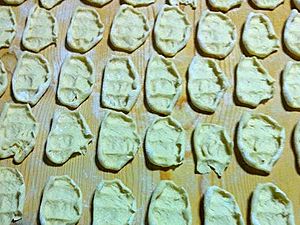Parmatieddi facts for kids

Uncooked parmatieddi
|
|
| Type | Pasta |
|---|---|
| Place of origin | Italy |
| Region or state | Campania |
Parmatieddi (pronounced par-ma-TYEH-dee) is a special type of pasta. It is also sometimes called Parmi or Parmitieddi. This pasta comes from a town called Teggiano in the Campania region of Italy.
Parmatieddi are a bit like another pasta called cavatelli, but they are usually bigger and flatter. People make them by rolling a piece of dough with three fingers of one hand. This gives them their unique shape.
Contents
What Are Parmatieddi?
Parmatieddi are a traditional pasta from southern Italy. They are known for their unique shape and how they are made. Unlike many other pastas, they are shaped by hand.
How Parmatieddi Are Made
Making Parmatieddi is a special skill. First, pasta dough is rolled into long, thin sticks. Then, a small piece of this dough is taken. Using three fingers, the dough is rolled and pressed. This creates a flat, slightly curved shape. This handmade process makes each piece unique.
Where Parmatieddi Come From
This pasta is a local specialty of Teggiano. Teggiano is a historic town in the Campania region of Italy. This area is famous for its delicious food and rich traditions. Parmatieddi are a part of this culinary heritage.
Enjoying Parmatieddi
Parmatieddi are often eaten as a first course in a meal. They are usually served with rich sauces and tasty cheeses. This makes them a hearty and delicious dish.
Traditional Sauces and Cheeses
One popular way to eat Parmatieddi is with a sauce called ragù. Ragù is a slow-cooked meat sauce, similar to a bolognese. It is very rich and flavorful. After adding the sauce, people often sprinkle grated cheese on top. Two common cheeses are pecorino or ricotta salata. Pecorino is a salty, hard cheese made from sheep's milk. Ricotta salata is a firm, salted version of ricotta cheese.
When Parmatieddi Are Eaten
Parmatieddi are especially popular on Palm Sunday. Palm Sunday is a Christian holiday that happens the Sunday before Easter. It celebrates an important event from the Bible.
The Meaning Behind the Shape
The unique shape of Parmatieddi is not just for fun. It has a special meaning. The pasta's flat, leaf-like shape is said to look like palm branches.
Palm Sunday and Its History
Palm Sunday remembers the day Jesus entered the city of Jerusalem. According to the Bible, a large crowd gathered to welcome him. They waved palm branches and laid them on the ground as he passed by. This was a way to show respect and honor.
Connecting Pasta to Tradition
The shape of Parmatieddi is a way to remember this story. It connects the food to a long-standing religious tradition. Eating Parmatieddi on Palm Sunday helps people celebrate and remember this important event. It shows how food can be a part of history and culture.

